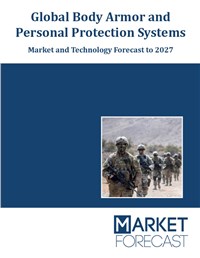Global Body Armor and Personal Protection Systems market report cover the military segment of the market. This market is dominated by North America, which accounts to around 30% of the total market. The market dynamics in Europe and North America are similar, however there is a startling difference in market dynamics between matured markets and markets in APAC. One of the key differences is that the matured markets focus on value addition of the product, the components of the value addition in this market are cost, weight, mobility and strength. The procurement spree by countries in APAC coupled with the unit requirement in each country has resulted in APAC being the fastest growing region in the world.
The report titled “Global Body Armor and Personal Protection Systems- Market and Technology Forecast to 2027” is segmented into four, which are region wise segmentation, product wise segmentation, user wise segmentation and armor type. The product wise segmentation covers body armor, tactical vest, combat helmet, pelvic protection system, life jacket system, combat eye protection and others. The Pelvic Protection System (PPS) is the newest entrant in this segment and is also expected to experience the fastest growth. The increase in use of Improvised Explosive Devices (IED) against troops positioned overseas are one of the key drivers for the PPS market.The other drivers in the overall market include the urbanization of warfare, wherein the battle field scenarios have changed from open field to door to door search operations. The closer proximity to the enemy increase the probability of use of small arms against troops, this has been one of the key drivers in this market. The advancements in material sciences which has helped in producing lighter armor, thereby increasing the mobility has encouraged the troops to use armor without combat challenges. The other drivers, restraints and challenges have been discussed in the report in the Market Analysis section.
The study period for the report titled “Global Body Armor and Personal Protection Systems- Market and Technology Forecast to 2027” is 2017 to 2027, the forecast period is 2019-2027. The total market is expected to surpass USD 17.5 Billion during the study period.
The in-depth coverage of the report across its sections are:
- Overview and Market Trends: This section covers a brief evolution of armor across US and UK, and also the modern body armor programs across the two countries. The section also covers the evolution of inserts, which are SAPI, ESAPI and XSAPI. The report also covers the key factors which govern fabric performance like the fiber architecture and boundary conditions. The chapter also covers the lightweight materials which are used in military armor.
- Market Technologies: The top eight technologies that could shape the future of Body Armor and PPS market are covered in this section. There is a clear shift from individual products to a system, the combat helmet is an example which has evolved from a life saver system to a combat enabler system. The future combat helmets are expected to include communication systems and other support systems, these are aimed at improved situational awareness which would directly increase the chance of survivability.
- Market Analysis: This section of the report deals with the key drivers, restraints and challenges of this market. This sections also covers in detailed the Porter’s five forces and PEST Analysis.
- Market Forecast: This section covers the market forecast of this market, the forecast has been covered for four segments, which are based on product, region, type of armor and end user. The body armor has been segmented as hard and soft armor based on type, the advancements in the field of material sciences have helped higher adoption of hard armor in matured markets.
- Opportunity Analysis: The sector which has the maximum opportunity across the forecast segments have been discussed in detailed in this segment.
- Company Profiles: Most of the major companies involved in Body Armor and Personal Protection Systems have been covered in the company profiles section.
Scope:
-
The report covers the Military Body Armor and Personal Protection Systems across the five user segments, which are tactical teams, ground forces, air force, navy and others.
Reasons to Buy:
-
The report will help the buyer to understand the key market trends, technology trends and market forecast in the Global Body Armor and Personal Protection Systems Market.
-
The report will help potential investors to understand the key opportunities across the segments in this market.
-
The report will help investment companies and other financial institutions to understand the market dynamics of the Body Armor and Personal Protection Systems Market.
-
The report would help potential market entrants to have a focused approach towards markets that could yield maximum results.
-
The report would help top management of material sciences companies to understand the key criteria for decision making amongst the Body Armor and Personal Protection Systems end users.
-
The report could also be of help to technology companies planning to invest in future technology in this market.




